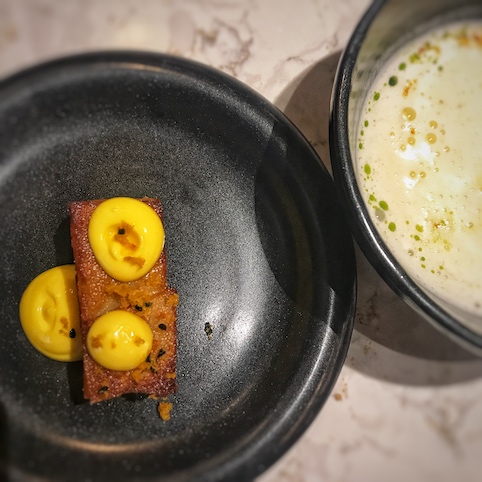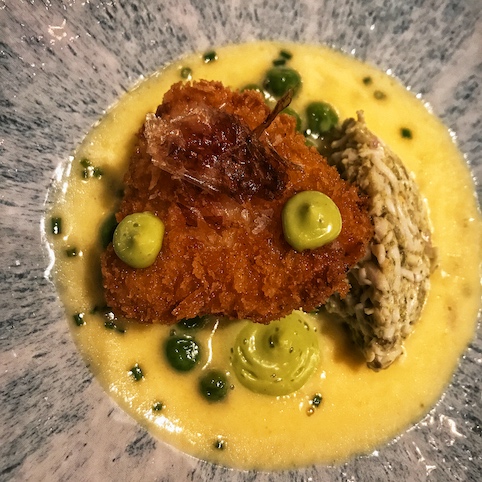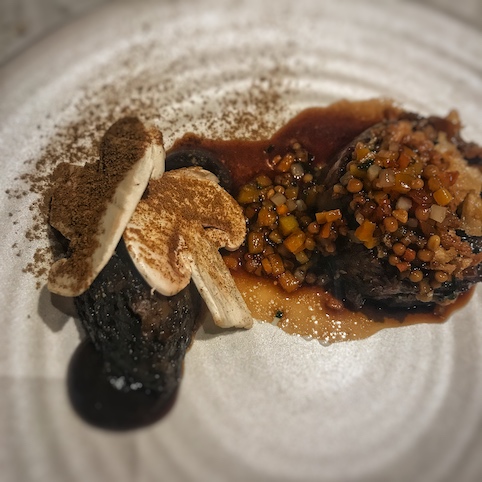And it’s not a cruise anymore, Eurotunnel Le Shuttle makes the going fast and easy and VAT refunds make it even more of a bargain.
Anyone my age might remember their dads bundling them, sleepy and complaining, into the Ford Cortina well before dawn to drive down to Dover and catch a ferry to France.
Cue hours of mal de mer and boredom, followed once landed, by a manic zoom around the Booze Barns before wheeling groaning shopping carts full of drink to the car to catch the return ferry just before it sailed.
Then finally home at midnight, with dad fit to be tied swearing ‘never again’ and the rest of us fast asleep.
Happy days? No, not really, but things have changed.
Under Not Over
Hearing that super-fast Eurotunnel LeShuttle have got together with French supermarket giant Carrefour to offer passengers a €10 gift card for every €100.01 spent in store until 30th November 2021, I was once more interested in making the trip.
And even more interestingly, post-Brexit UK residents can now get a VAT refund (up to 20%) on items bought in France including cosmetics, technology, jewellery, and of course food and drink items.
And Carrefour Calais is part of Cité Europe, a massive modern mall a short drive from the Eurotunnel terminal. Lots of shopping opportunities there,
How Do You Like Them Apples? The English Apple And Pear Harvest Has Begun.
I join Chef Raymond Blanc to visit an apple and pear farm and see one of the UK’s food treasures begin its glorious, and green, journey to your fruit bowl.
Apples, apples everywhere – Gala, Braeburn, Jazz, Cox and English Bramley. The colours sing off the trees in all directions on Boxford Farms giant apple and pear orchards in Suffolk . Reds, greens, bicoloured and yellows and all shades in between.
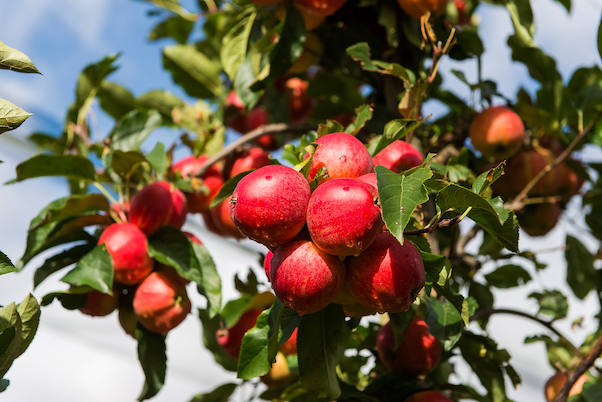
The colours are especially vibrant this year as Ali Capper, Executive Chair of British Apples &; Pears Limited who is with us in the field explains: “Most British dessert apples have a beautiful colour to their skin that is created, in part, by our fantastic maritime climate which lets the apples mature slowly, and this year is no exception.” It’s why apples from abroad rarely please the eye as much.
And let’s talk about ‘green’. Robert Rendall from Boxford Farms, a third-generation family business, is enthusiastic about his growing methods. “As a business we already produce more green energy and recover more water than we use, and it is our goal to be a carbon sink by 2027.”
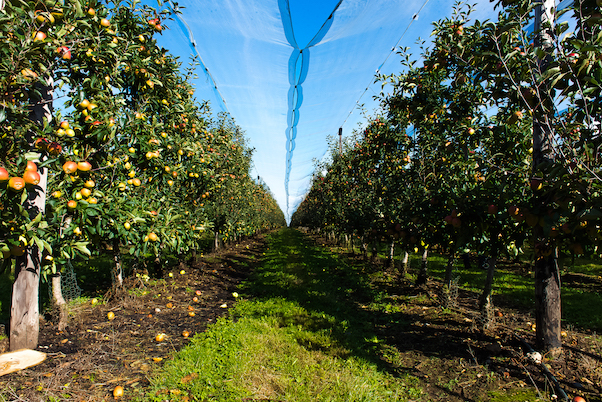
Like 93% of growers he uses biodiversity measures, such as varied grasses and wildflowers to encourage insects, as well as creating beetle banks and bee hotels to encourage natural pollinators.
Nothing goes to waste here, the apples that naturally fall before they can be harvested are not allowed into the food chain by law, but they make excellent fodder for the farm’s Anaerobic Digester. This turns the apples into Biogas, enough gas to produce heat and electricity for the farm’s needs and often enough surplus to sell.
Chef Raymond Blanc nods approvingly at Robert’s words and crunches into another apple. We’ve only been out here fifteen minutes and he must have already eaten three at least, he certainly takes his role as ambassador seriously.
A few minutes later he’s got another apple in his hand, as he good naturedly follows the tabloid photographer’s directions to stick his head through a wall of apple trees and bite down for the camera.
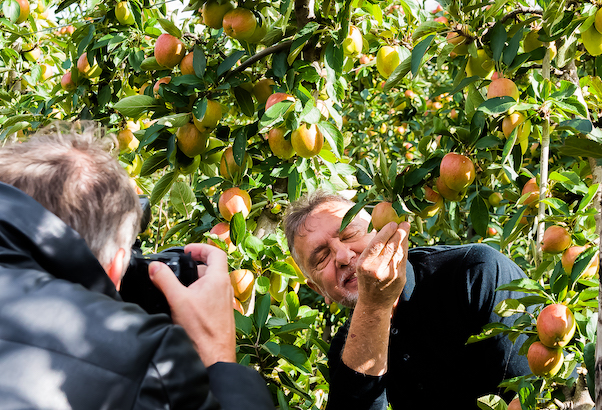
“Britain produces some of the finest apple and pear varieties in the world,’ he says, ‘and it is hugely important to me that we support our home grown produce. With so many wonderful varieties available this season in an array of beautiful colours, textures and flavours, there really is a British apple to delight everyone.”
And he says we should all recognise the work that goes into getting apples to us as we’re shown how the apples are harvested, always by hand as no machine can beat the skill of a human picker.
Ripe for picking
Firstly it’s about knowing when the apple is right. That comes with experience, but also today by science. One device that’s used tests the firmness of the apple on the tree – rock hard is under ripe, the apple should give to the teeth.
Then there is the starch iodine test. As apples ripen their starch is replaced by sweetness. The test apple is stained with a 4% potassium iodide/1% iodine solution. As the apples become ripe, they go from a dark iodine staining to a lighter staining.
And finally there is the refractometer; a small amount of juice from the fruit is squeezed onto the prism of the refractometer which is then held up to the light and the percentage of soluble solids is read by looking through the lens. Chef Raymond has a go and soon resembles Admiral Nelson looking for ships.
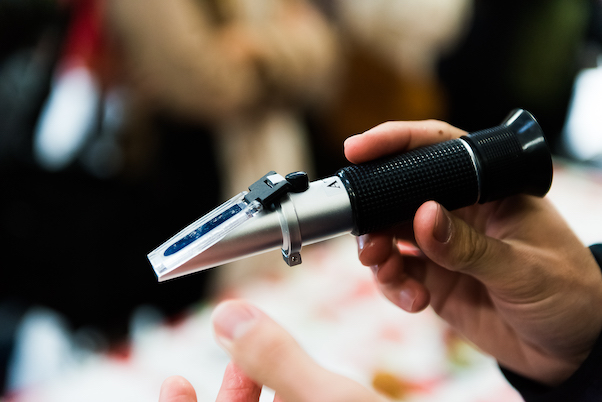
It’s in the wrist action
Every aspect of the harvest is an exercise in care. Each apple is picked by a twisting wrist movement, ‘you never pull,’ I am advised by a pro who is watching me carefully as I try. ‘Twisting means the little spur branch stays on the tree to produce fruit next year, and there’s less risk of shaking other apples to the ground. And use your palm to grasp,’ he admonishes me, ‘not your fingers which might bruise the apple. If the apple doesn’t want to come away easily, it’s not ripe so leave it.”
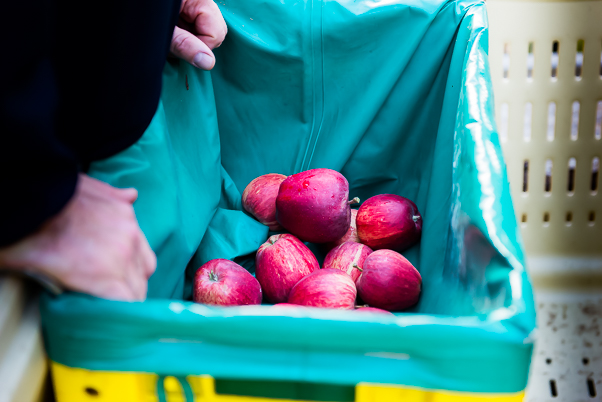
Each apple is carefully placed in a cloth lined box on the tractor hopper- never dropped in. When the box is full the apples are gently transferred to the main hopper.
‘We take all this care,’ one of the pickers says ruefully ‘and then I go into some supermarkets and see the shelf fillers just tumble the apples in!’
That is a shame, we all should respect English apples, an original and unique English crop that’s been grown here commercially since Henry VIII set up the first large-scale orchards in Kent.
An apple a day
So do try as many varieties as you can, as they are all in their prime and in the shops now.
Try them with cheese, for example, apples partner excellently alongside cheeses with each variety’s unique textures and tartness add to the taste experience. Sweet is not always the most exciting kind of apple, although it remains the most popular.
British Apples are a sustainable green choice, endorsed by a top chef and easily enjoyed by everyone. Look out for them in the shops from this week onward.
Try these delicious apple recipes.
The Little Lobster Bar Review
Fresh from the mother restaurant down the road, Bob’s Lobster has docked it’s smaller ship in Borough Market to dispense all manner of lobster loveliness to hungry passing punters.
“That’s a quidsworth you’ve dropped there,’ L says casually, as I battle to contain my Lobster & Crayfish Roll from disintegrating entirely onto the table.
She’s probably right, this seafood monster costs £19, so every bit is sacred and not a morsel can be wasted. I scoop up the chunk of dropped lobster, with the edge of my finger and then eat it. I’m sure the table’s clean enough and I hate waste.
It is one heck of a roll, containing lobster claw, tail and knuckle, as well as crayfish, in a toasted brioche bun all doused in rapeseed mayo and sprinkled with house celery salt. You need three hands to eat it but boy is it good, the lightly toasted bun’s slight dryness balancing out the rich filling. The meat is generous and sweet.
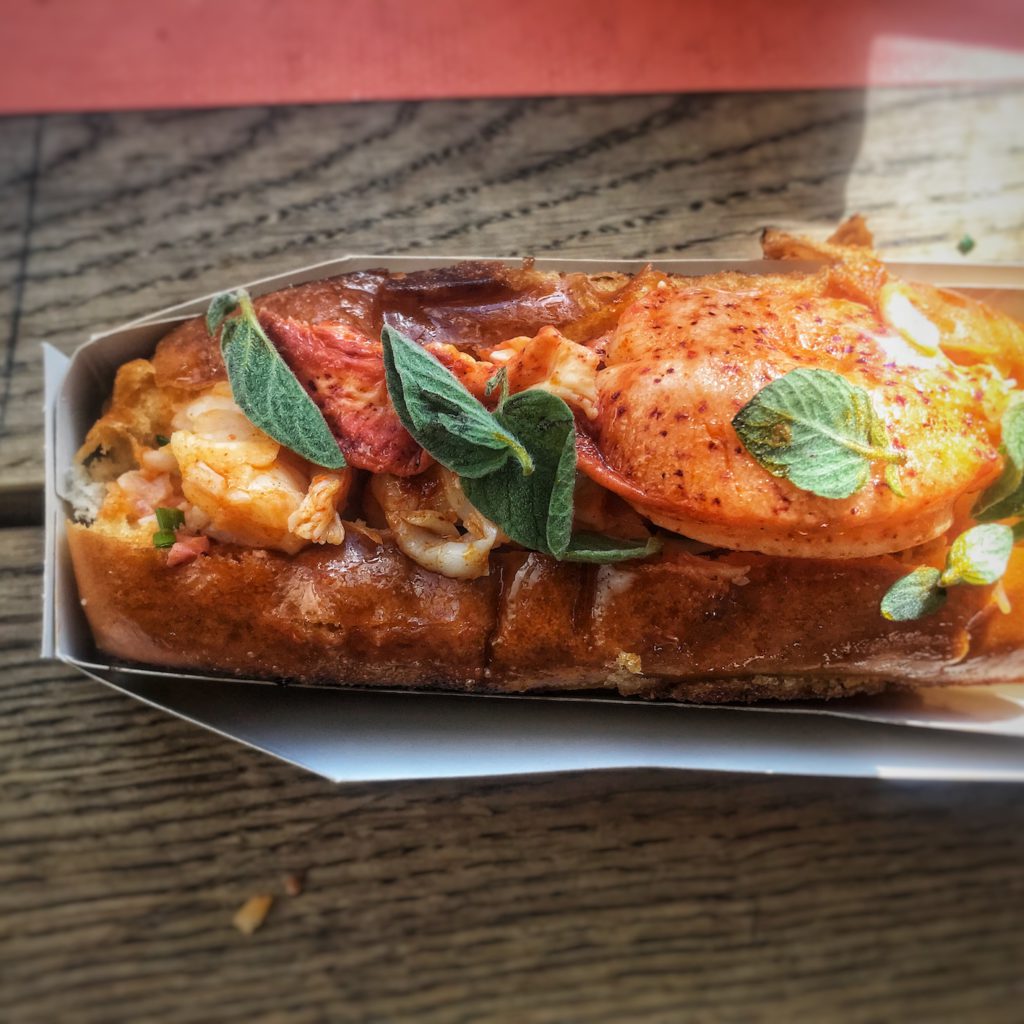
It’s gloriously rich and yet unpretentious, rather like the surroundings. We’re sitting in the large hall part of Borough Market, a section that is being slowly turned into a food court and the first resident is BOB’s Lobster’s Little Lobster Bar
They’ve extended their crustacean operation from their main restaurant by bringing around Ruby, their original 1957 Vintage VW split screen converted Campervan to serve as a small kitchen,as well as eye candy.
The space around is for now a bit bleak, the Campervan is the only splash of colour, but while they wait for others to join them Bob’s Snappers do have plenty of room for tables. Which is good as this is not the kind of food to ideally eat on your feet, unless you want your shoes splashed.
We’re having a bit of a seafood fest in the breezy space with these native lobster from the south coast and the Shetlands.
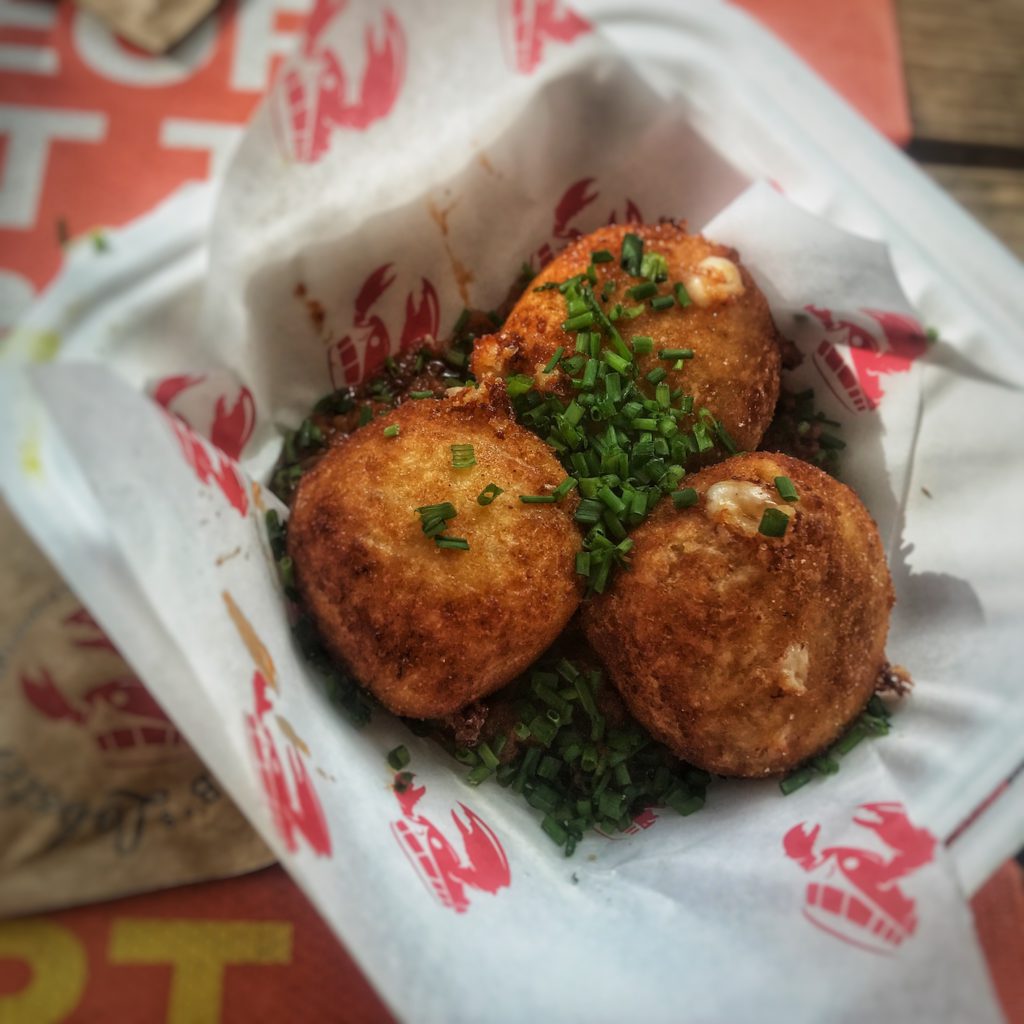
Three lobster arancini on a semi- spicy tomato base are gloriously stringy with mozzarella cheese. Arancini were once a peasant’s way of using up leftover risotto, but with the addition of lobster they become gentrified and then some more. Three between two of us results in a clash of wooden forks.
And then there are the Crab Tacos; warmed corn tortillas filled with hispi slaw, guacamole, crab, cashew butter, fresh herbs, lemon and Valentina hot sauce.
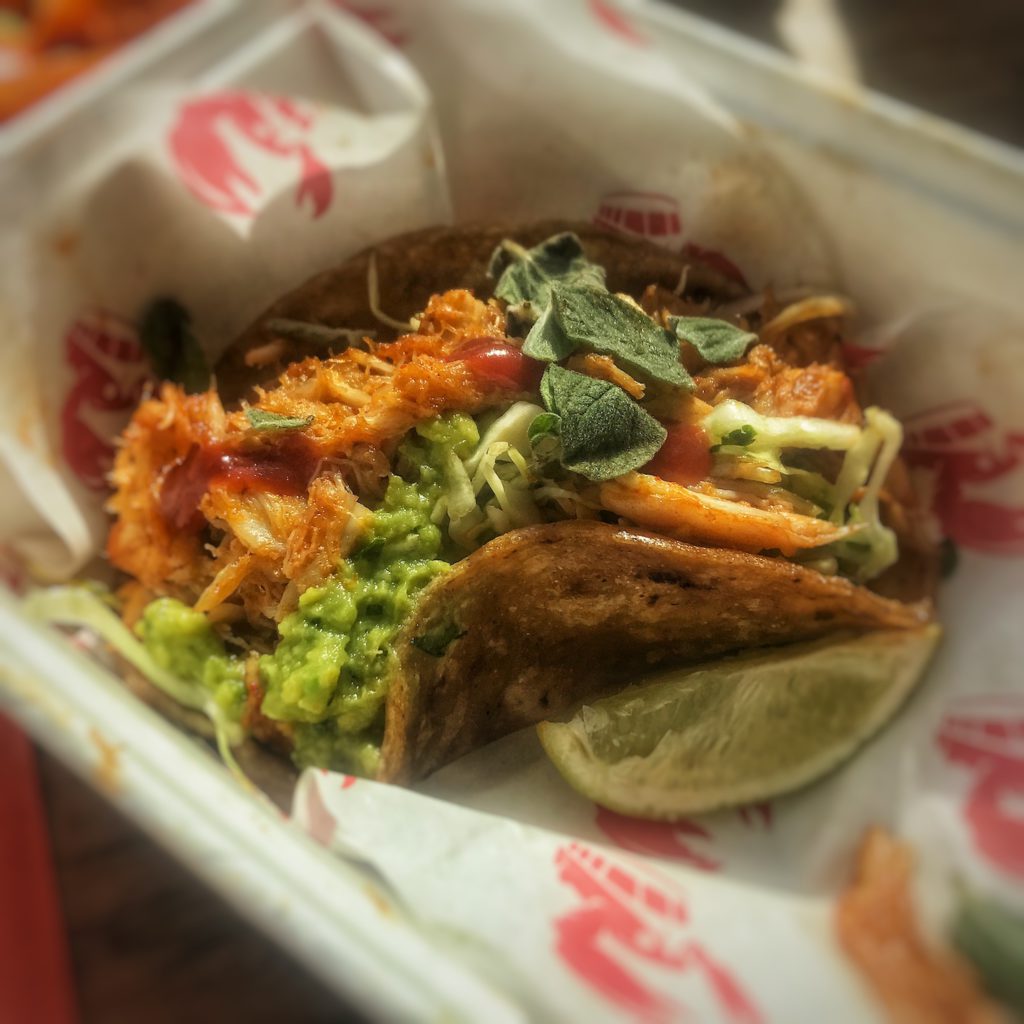
I think maybe these are my favourite. There’s an awful lot going on inside, as is kind of obligatory these days of more meaning more, but the flavours manage to remain distinct. That said, a bit more of that hot sauce wouldn’t have gone amiss.
We’re washing it all down with Prosecco which, along with Champagne Laurent-Perrier, frozen margaritas and van-made, Southern style lemonade, is part of the drinks menu. Perhaps they should have called this pop-up Bubbles and Bobs?
We are understandably quite full by now, becoming part lobster ourselves, but it would be rude to leave without sharing a Lobster Mac ‘N’ Cheese.
This is three cheeses, macaroni, lobster bisque bechamel, lobster tail and knuckle meat and topped with crispy shallots and oregano.
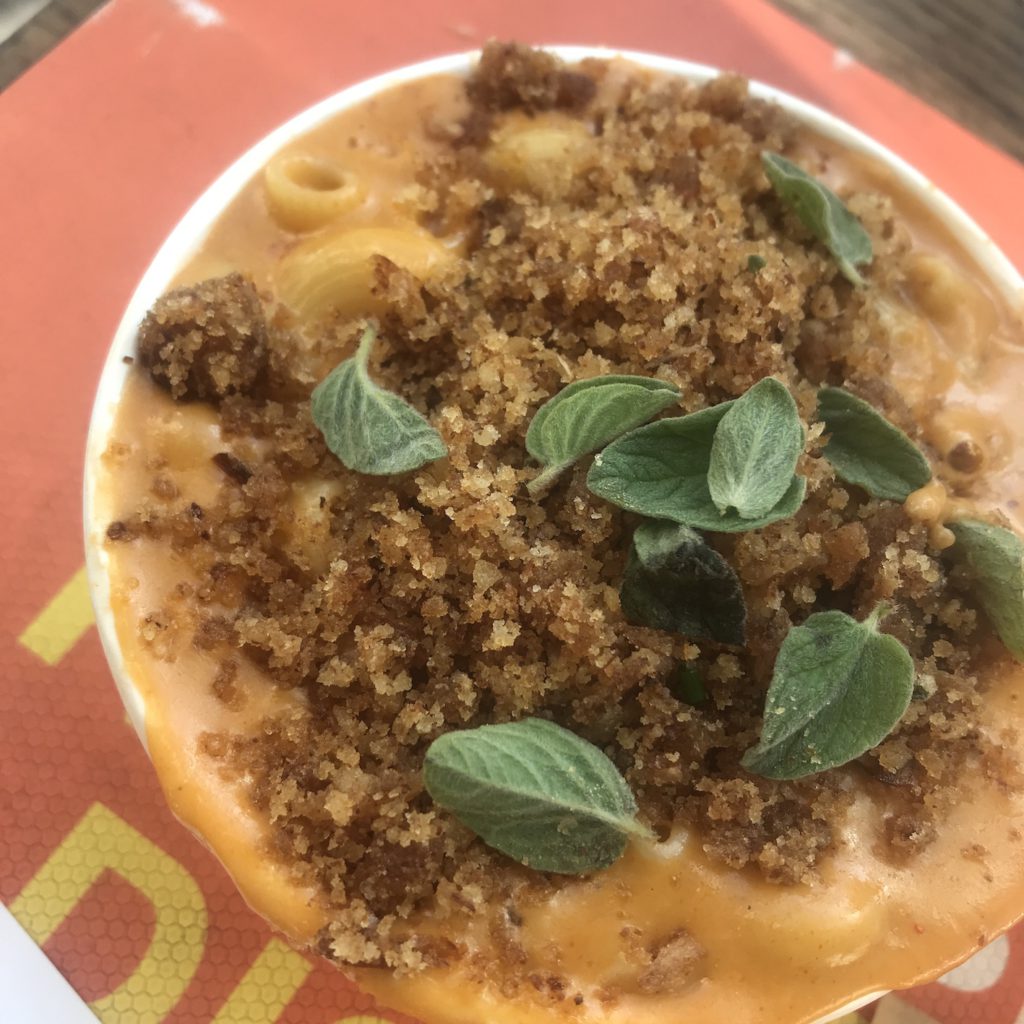
It’s as rich as Bill Gates and easily more than enough for one person, in fact even two of us gourmands had to reluctantly leave some in the pot. A frantic mix of flavours, it’s the sort of comfort dish that rappers might go for – recognisable as home cooking, but only if home is a penthouse.
We leave with our carapaces strained to bursting, perhaps on reflection I should have let that bit of lobster roll escape after all.
The Little Lobster Bar is open Tuesday to Saturday
11am to 5pm and until 6pm on Fridays. In the evenings the 60-cover space can be hired out for events.
BOBs Lobster Market Hall, Bedale Street, Borough Market London, SE1 9AL
Yoast SEO
Six By Nico.Canary Wharf
It’s all in the name – ever changing, very affordable, six course tasting menus from the mind of Chef Nico Simeone.
It’s been an astonishingly fast journey for Nico Simeone. From his first restaurant in Glasgow in 2015, he’s now knocking it for six all over the UK.
The concept is simple; an affordable, innovative, tasting menu of six courses that changes every six weeks.
Tasting menus? I hear you cry. Surely no one wants those anymore? In the wrong hands they had become a byword for a culinary theatre of cruelty, one where demonic chefs crazed with self importance battered you with course after course until you became angry and desperate to escape.
In theory though, a menu of innovative small plates cleverly thought through is a good idea if kept sensible in length (I once had a twenty four course menu that was unforgettable for all the wrong reasons), they are easily eaten and enjoyed.
So Six it is and for the opening six weeks In his new Canary Wharf restaurant Simeone has brought back his original hit The Chippie first served in Glasgow in 2017. It’s a meal themed around fish and chips, pies, and a deep fried Mars bar.
First though we add to our bill by trying an aperitif called Seaside 75. To a glass of Earl Grey, Prosecco and lemon juice we stir in samphire and sea salt. This causes the glass to froth like those chemistry lessons where you added baking powder to vinegar. A nice bit of fun and a refreshing drink.
Also off-piste is what’s called ‘a snack’. Superb sourdough bread with rich shellfish butter that’s as iron grey as a battleship, plus cannelloni made from filo pastry and stuffed with salty taramasalata and topped with lemon gel and a smattering of caviar. Don’t try eating the pebbles, they’re real.
Curry sauce is not a chippie thing in the soft south, but north of Midland Keynes they can’t get enough. First course proper is Chips & Cheese – potato terrine cut into a chip and topped with a curry oil mayo that has the Proustian aroma of 1970s curries (if you’re old enough to remember those, that is).
A bowl of foamed Parmesan is where you dip your chip, a powerful and rich sauce that we both ended up scraping out the bowl with the desperation born from knowing that it was coming to an end.
Of course you need battered fish in a chippie, and it came as a ‘scampi’, but made with a chunk of monkfish cheek. Once upon a time monkfish was regarded as a cheap version of scampi, my mother used to warn of restaurants that tried passing it off. Hard to believe now with monkfish being more expensive.
A rich dill and butter sauce set off the cheek, along with a tangy gribiche sauce (posh tartare) and peas, which I thought were a bit starchy and undercooked.
A good chippie always has a few pies in its warming section, usually wrapped in plastic and containing meat whose origin it’s best not to speculate on. Nico’s take on this is a mini jewel of steak pie made from unimpeachable Speyside beef shin accompanied by mushroom duxelle and an onion ketchup that hints at HP but soars above it.
This is just the right size; any larger a portion and I’d have been done for. As it is, I am soon refreshed and ready for the ‘Big One’.
The Fish Supper is a lovely chunk of Shetland cod cosied up with sharp and briny pickled mussels, a remarkable confit fennel and crisp, salty samphire. A beer emulsion brings it all together.
The final savoury almost tips me over. It’s a heavy one that picks up on the theme of the dubious sausages and frankfurters usually found in a chippie, but of course is all high quality here. It’s a trio of porky bits with apple, black pudding, salt baked celeriac and a sharp choucroute to cut the fats.
It’s very good but I am glad it’s the last of the mains, I am flagging now, so dessert ahoy. And what else could it be but ‘deep fried Mars Bar’.
Did this dish ever exist, or was the story of how a chip shop in Scotland made them in the mid-1990s just an English joke about the Scottish diet? Who knows, but it’s a great story and here is its 2021 interpretation.
It’s not of course a real Mars Bar chez Nico, but a slab of chocolate pavé topped off with a deep fried dough ball and dished on a bed of chocolate soil (hello Heston) alongside a quenelle of Irn-Bru sorbet. Irn-Bru for those not familiar with it, tastes rather like Tizer although Scottish people get rather upset when you say that.
It’s a great finale to a great meal which comes in, without the extras we had, at a remarkable £37. When you think about what cod and chips cost in a chippie these days, that’s a real steal.
We also had the matched wines for an extra £33. Great choices, lucidly but not boringly explained each time by the charming staff.
The look of the restaurant, the cool staff and the superlative cooking make this one of London’s best deals for an affordable real treat. Okay it’s in Canary Wharf, and not everyone works there, but it’s a simple and short ride from central London.
Fish lunch or fish supper, it’s your choice, but hurry as the menu changes on September 17th.
Six by Nico Canary Wharf
6 Chancellor Passage,
London,
E14 5EA
www.sixbynico.co.uk | IG: @sixbynicocanarywharf
Getting The Bee(r)s In With Hiver Beer
Bees make honey, honey makes great beer. Nick Harman goes to meet the buzzing workers in South London and of course taste some of the honey beer.

‘I’ll just make sure the Queen is still in there before I put the frame back in the hive,’ says Barnaby Shaw, Lead director at Bee Urban, as we observe apprehensively from inside our bee suits.
It’s spitting with rain and the bees seem spitting angry too. They need to have their home put back together asap. ‘It’s a bit late in the day to disturb them’, says Barnaby peering closely at the frame, still looking for the Queen who will be marked with a coloured dot. ‘The bees are usually active between about 10am and 4pm and out foraging. Now they need to rest’.
The ones trying to get at my face could certainly give it a rest. Although I’m totally secure behind my spaceman mask, the bees are right up in my grill and while I know they can’t get past the mesh visor, I still feel a bit uneasy. And is that something crawling up my ankle? Continue reading
La cuina dels genis. The cooking of the geniuses.
Discovering the Catalan dishes and landscape that inspired Gaudi, Picasso, Miro and Casals.

I’m holding a large loaf that I’ve just hollowed out, it’s now filled with herring, roasted tomatoes and garlic and a very great deal of olive oil.
Biting into it I temporarily lose sight of the beautiful convent at the foot of the mountain across the fields from the village of Horta de Sant Joan in Catalunya.
Bread completely fills my vision and olive oil runs down my sleeves. Now this is what I call a sandwich. Continue reading
When is a cow not a cow? When it’s a Txuleton
Before I begin, I assume none of you lovely readers are vegans or vegetarians? If so, you might want to stop reading now.
I myself eat meat, but not a lot. So, when I do eat it, I want something special.

Txuleton is that something special.Txuleton, or rib, steak usually comes from the Rubia Gallega cow.
It’s a cow from North West Spain that can be as old as 18 years before being turned into steaks.In the Basque country old dairy cows are used.
That is pretty old. I mean in the UK beef is usually slaughtered before the cow gets to three years.
Normally dairy cows past their milking prime are disposed of, but in the Basque country they are fattened up for eating.
So why are old cows so good?‘
Well’, says Sagardi Shoreditch’s meat selector Imanol Jaca, ‘it’s because mature muscle and fat tastes better and myoglobin in the muscles means a redder meat’.

Come for the food, stay for the footy
‘Who ate all the pies?’ Actually, it’s more a case of who ate the crab pannacotta and then the sea bass with salsify? Nick finds his first football match to be a surprisingly tasty experience.

I have a confession to make; although I am an old geezer I have never been to a football match in my life. Until last Saturday.
My father was not remotely interested in football and my school played rugby. Ok, yah? So, I was never going to be a football fan.
Plus, back in my teenage years, football was at its lowest point; mindless violence, both in and out of the stadiums, standing up in the cold for the whole ninety minutes and food that was barely worthy of the name. It really never appealed to me.

But, Watford FC’s, Hornets Hospitality, has recently been awarded the highest accolade in Premier League hospitality. Continue reading
Taking the cure. Discovering proper smoked salmon at H.Forman & Son
Smoked salmon, once seen as a luxury food on the same level as caviar, is now available everywhere, but don’t be fooled by cheap imitations, says Nick.

‘Our old factory was roughly where the centre of the running track is now,’ says Lance Forman gesturing through the window in the direction of the site of the London 2012 Olympic games, a few hundred metres away.
It’s evidently still something of a sore point with him how, after over a century in the same place, the family firm of H.Forman was forced to move out so a wrecking ball could come crashing down. Continue reading
BOB’s Lobster, London Bridge.
BOB’s Lobster is a quite a catch, super fresh seafood in a modern diner setting and with some very inventive dishes that don’t all involve the lobster.
 As I get older I find myself more and more doing that mindless humming thing, not even aware I am doing it, at least until I catch people looking at me with the ‘who’s the loon?’ expression.
As I get older I find myself more and more doing that mindless humming thing, not even aware I am doing it, at least until I catch people looking at me with the ‘who’s the loon?’ expression.
I was humming again going into BOB’s Lobster, but this time I was humming the B-52’s classic ‘Rock Lobster’. It was impossible not to. Continue reading


